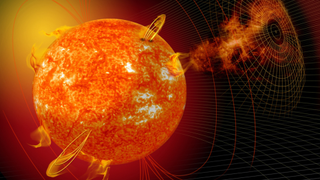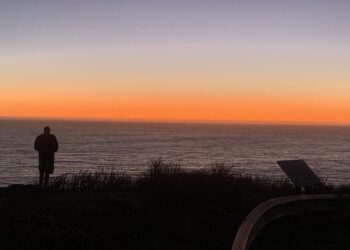Home
News
Science & Astronomy

An illustration shows the sun as it throws out a coronal mass ejection that can contain millions of tons of stellar material.
(Image credit: NASA)
While the U.S. celebrated Independence Day on July 4, the sun held its own, more powerful firework display.
The stellar fireworks came in the form of two solar storms, or coronal mass ejections (CMEs), that are partly directed at Earth and were observed by NASA’s Solar and Heliospheric Observatory (SOHO) that orbits our star. CMEs can contain as much as a billion tons of plasma made up of charged particles and thus carry with them their own magnetic fields.
NASA has projected that the massive ejection of ionized gas called plasma will impact Earth by Friday (July 7). When the charged particles within CMEs strike the magnetic field of our planet, the magnetosphere, they can give rise to large disturbances called geomagnetic storms.
These storms can, in turn, disrupt power and communication infrastructure here on the surface of Earth in addition to affecting satellites, which could adversely influence services such as the global positioning system (GPS).
Related: Sun breaks out with record number of sunspots, sparking solar storm concerns
Space Weather physicist Tamitha Skov shared footage of both CMEs recorded by the SOHO’s Large Angle and Spectrometric Coronagraph Experiment (LASCO) on her Twitter feed. Skov wrote: “Our #Sun celebrates #July4 with its own special fireworks! We have two partly Earth-directed #solarstorms (aka CMEs) on their way. The second storm will catch up to the first giving us a 1,2-punch. Model predictions show impact likely July 7. I’ll post NASA model runs next”
Our #Sun celebrates #July4 with its own special fireworks! We have two partly Earth-directed #solarstorms (aka CMEs) on their way. The second storm will catch up to the first giving us a 1,2-punch. Model predictions show impact likely July 7. I’ll post NASA model runs next. pic.twitter.com/gtJwgcYS4ZJuly 5, 2023
See more
As promised, the space weather expert shared models of both CMEs, created by NASA’s Chris Stubenrauch, describing the outflows of stellar matter as a “double punch” of solar storms.
The first tweet showed the initial CME, which NASA predicted is slower and will arrive before 8 am (EDT) on Friday and will head mostly to the northeast.
The Sun launches double punch #solarstorms on #July4th! NASA prediction shows impact before noon July 7 UTC. The first storm is slower & will go mainly northeast. The second is faster & more a direct hit. Fast solar wind follows. G1-level possible with #aurora to mid-latitudes. pic.twitter.com/HhVIsgZcDrJuly 5, 2023
See more
The second CME is hurtling through space more rapidly and will result in what Skov described as more of a “direct hit” on Earth, with it veering slightly southward. It should arrive in the early hours of July 7.
Here is the second, faster #solarstorm that is more of a direct hit, but going slightly southward. Again modeled independently thanks to Chris Stubenrauch at NASA/M2M. pic.twitter.com/mvAfFsut16July 5, 2023
See more
She added that the CMEs have the possibility of triggering a G-1 level geomagnetic storm, defined by the National Oceanic and Atmospheric Administration (NOAA) as minor events that can, nonetheless, give rise to power grid fluctuations and impact spacecraft operations.
While the fireworks of Independence Day are long over, the CMEs could also result in another spectacular light show, this time high in the atmosphere over Earth. When charged particles travel down the magnetic field lines in Earth’s magnetosphere, they create bright, colorful displays called auroras. These are usually only visible at high latitudes on Earth near the poles, but these powerful CMEs could give rise to auroras that are visible at lower mid-latitudes.
The NOAA adds that auroras connected to G-1 geomagnetic storms can often be seen in the U.S. as far south as Michigan and Maine.
Join our Space Forums to keep talking space on the latest missions, night sky and more! And if you have a news tip, correction or comment, let us know at: [email protected].
Breaking space news, the latest updates on rocket launches, skywatching events and more!
Robert Lea is a science journalist in the U.K. whose articles have been published in Physics World, New Scientist, Astronomy Magazine, All About Space, Newsweek and ZME Science. He also writes about science communication for Elsevier and the European Journal of Physics. Rob holds a bachelor of science degree in physics and astronomy from the U.K.’s Open University. Follow him on Twitter @sciencef1rst.
>>> Read full article>>>
Copyright for syndicated content belongs to the linked Source : Space.com – https://www.space.com/sun-coronal-mass-ejection-double-punch-july-2023


















![[News] Japan Develops 10nm Nanoimprint Technology, with Potential to Tackle EUV Bottleneck – TrendForce](https://earth-news.info/wp-content/uploads/2025/12/329851-news-japan-develops-10nm-nanoimprint-technology-with-potential-to-tackle-euv-bottleneck-trendforce-360x180.jpg)












